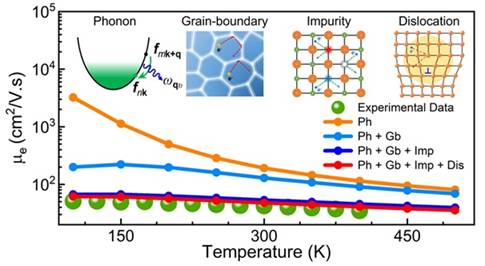Ministry of Science & Technology

Novel Insights into Electron Scattering in Semiconductors Creates Potential for more Efficient Electronic Devices
Posted On: 18 OCT 2024 3:12PM by PIB Delhi
In a significant advancement for the semiconductor industry, researchers have unveiled novel insights into the mechanisms that limit electron mobility in semiconductors. The study which represents a major leap forward in understanding the electronic properties of semiconductors, holds promise for developing more efficient electronic devices.
Semiconductors form the backbone of modern electronics, powering everything from smartphones and computers to advanced medical devices and space technologies. The search for new semiconductor materials has intensified as the demand for faster, more efficient, and more reliable electronic devices continues to grow. Scandium Nitride (ScN), a rocksalt semiconductor, has emerged as a promising candidate for next-generation electronics due to its high thermal stability, robustness, and electronic properties. However, despite its potential, the practical application of ScN in electronic devices has been hindered due to its relatively lower electron mobility. This key factor influences the speed and efficiency of semiconductor devices and researchers had been curious to unravel why the mobility of the electrons are limited.
Scientists from Jawaharlal Nehru Centre for Advanced Scientific Research (JNCASR), Bangalore, an autonomous institute under the Department of Science and Technology (DST) explored the factors that limit electron mobility in ScN. Their research spearheaded by Associate Professor Bivas Saha focused on identifying and analysing the dominant scattering mechanisms that impeded the flow of electrons and reduced their mobility. Through a combination of theoretical analysis and experimental validation, the researchers were able to pinpoint the specific scattering mechanisms at play. Their results showed that though interactions between electrons and longitudinal optical phonon modes, often described as the Fröhlich interactions set an intrinsic upper bound for ScN’s electron mobility, ionized-impurity and grain-boundary scatterings significantly reduced mobility. Therefore, depositing single-crystalline ScN that are devoid of impurities and defects is expected to increase its mobility significantly.
“The findings from this study have far-reaching implications for the global semiconductor industry. As manufacturers seek to push the boundaries of electronic device performance, the insights provided by our research could lead to significant advancements in the design and fabrication of ScN-based components,” said Prof. Bivas Saha. “By addressing the identified scattering mechanisms, it may be possible to engineer ScN materials with improved electron mobility, making them more suitable for a wide range of high-performance applications. These could include thermoelectricity, neuromorphic computing, high mobility electron transistor, and Schottky diode devices,” Sourav Rudra, the lead author of this study pointed out.
As the semiconductor industry continues to evolve, the findings from this study are expected to serve as a foundation for future research into scandium nitride and other semiconductors. Moreover, JNCASR’s work in the field of semiconductor materials is poised to have a lasting impact on the development of future technologies, contributing to India’s vision of becoming a global leader in science and innovation. Apart from JNCASR, Prof. Samuel Poncé, a researcher from the Université catholique de Louvain, Belgium also participated in this study.
The research findings have been published in the journal Nano Letters under the title “Dominant Scattering Mechanisms in Limiting the Electron Mobility of Scandium Nitride.”


***
NKR/AG
(Release ID: 2066046) Visitor Counter : 32




















